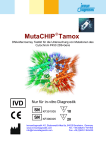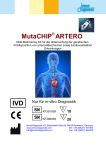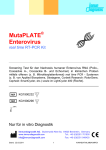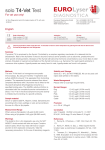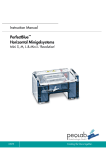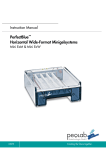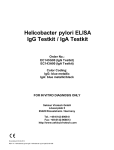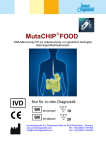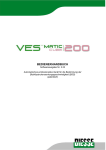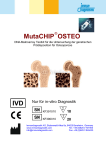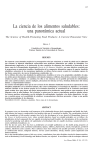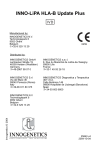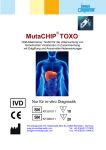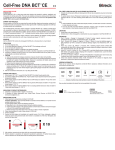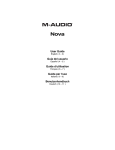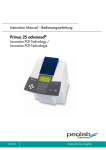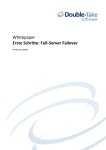Download Arbeitsanleitung - bei Immundiagnostik
Transcript
® MutaCHIP 5-FU DNA-Macroarray Kit zur Untersuchung von Mutationen des Dihydropyrimidin-Dehydrogenase-Gens Nur für in-vitro Diagnostik KF391006 10 KF390006 20 Immundiagnostik AG, Stubenwald-Allee 8a, 64625 Bensheim, Germany www.immundiagnostik.com Tel.: +49 (0)6251/ 701900 [email protected] Fax: +49 (0)6251/ 849430 2 Inhaltsverzeichnis 1 Verwendungszweck 3 2 Einleitung 3 3 Testprinzip 4 4 Kitbestandteile 4 5 Erforderliche Materialien 5 6 Lagerung und Haltbarkeit 5 7 Arbeitsbedingungen 5 8 Hinweise und Vorsichtsmaßnahmen 6 9 Probengewinnung 6 10 Testdurchführung 7 1 PCR ................................................................................................................................... Produktherstellung 7 2 PCR ................................................................................................................................... Protokoll 8 3 MutaChip ................................................................................................................................... Protokoll 9 11 Auswertung 11 12 Troubleshooting 15 © 2012 Immundiagnostik AG / Version 3.0 Verwendungszweck 1 3 Verwendungszweck Das MutaCHIP 5-FU® Kit ist ein molekularbiologischer Test zur Untersuchung von Mutationen des Dihydropyrimidin-Dehydrogenase-Gens (DPYD) aus genomischer DNA mittels MutaCHIP Technologie. Alle untersuchten Variationen stehen in Zusammenhang mit einem erhöhten Risiko für das Auftreten von schwerwiegenden Nebenwirkungen während einer 5-Fluorouracil (5-FU)-haltigen Chemotherapie. Folgende Variationen werden durch den MutaCHIP 5-FU Kit detektiert: DPYD*2A DPYD*3 DPYD*4 DPYD*7 DPYD*8 DPYD*10 DPYD*12 DPYD*13 DPYD M166V DPYD A551T DYPD D949V 2 Einleitung Neben Einflüssen wie Alter, Geschlecht, Ernährung und Komedikation können insbesondere genetische Faktoren die Enzymaktivität beeinflussen. Es ist bekannt, dass Patienten, die keine bzw. eine stark reduzierte Aktivität des Enzyms Dihydropyrimidin-Dehydrogenase (DPD) aufweisen, unter einer Therapie mit 5-Fluorouracil (5-FU) ein erhöhtes Risiko für das Auftreten schwerer bis tödlicher Nebenwirkungen (gemäß WHO Grad 3-4) haben. 5-FU ist ein Zytostatikum, das standardmäßig zur Therapie einer Reihe von Tumorerkrankungen eingesetzt wird. Die Untersuchung des DPYD-Gens kann helfen, das genetisch bedingte Risiko einer Nebenwirkung stark zu reduzieren bzw. zu vermeiden. Träger einer der untersuchten genetischen Varianten des DPYD Gens können somit vor Beginn einer Therapie ermittelt und ggf. mit einer alternativen Therapie oder mit deutlich reduzierter Dosierung behandelt werden. Von allen Patienten, die trotz einer genetischen Variante des DPYD-Gens mit 5-FU behandelt werden, erkranken über 40 % an schweren Nebenwirkungen (Grad 4). In vielen Fällen können 5-FU-bedingte Nebenwirkungen mit dem Vorliegen einer Mutation im DPYD-Gen erklärt werden. Die Genotypisierung kann helfen, medikamentöse Therapien individuell zu optimieren und durch unerwünschte Nebenwirkungen entstehende Kosten (verlängerter Krankenhausaufenthalt etc.) zu senken. Referenzen: Mol Cancer Ther. 2006; 5(11):2895-2904 Clin Cancer Res. 2004; 10(17):5880-5888 Clin Cancer Res. 2006; 12(13):3928-3934 Pharmacogenomics. 2001; J1:65-70 J Clin Oncol. 2008; 26(13):2130-2137 © 2012 Immundiagnostik AG / Version 3.0 / 04.12.2012 4 3 Testprinzip Zur Analyse der Mutationen werden die relevanten Teile des DPYD -Gens mittels PCR amplifiziert, wobei frisch extrahierte genomische DNA des Patienten als Matrize dient. Das Amplifikationsprodukt wird anschließend auf den MutaCHIP gegeben und nach mitgeliefertem Protokoll bearbeitet. Die Analyse mittels Präzipitationsreaktion lässt eine eindeutige Genotypisierung aller auf den MutaCHIP gespotteten Allele des DPYD-Gens zu. Das amplifizierte Produkt wird auf den MutaCHIP gegeben und bindet an den dort immobilisierten Sonden. Durch einen Waschschritt werden unspezifisch gebundene Fragmente wieder entfernt. Im Anschluss wird das Enzym hinzugegeben, welches an den Sonden-Fragment-Komplex bindet. Nach Zugabe des Substrats tritt eine Fällungsreaktion an den Stellen, an denen noch DNA gebunden ist, auf. Das farbige Präzipitat wird mit dem Imagereader detektiert und von der dazugehörigen Software ausgelesen und bewertet. 4 Kitbestandteile Jedes Testkit enthält die folgenden Reagenzien zur Durchführung von 20 MutaCHIP 5-FU Assays, sowie eine Gebrauchsanweisung. Bezeichnung Gefäßgröße Menge Primer Mix A (grüner Deckel) 2 mL Schraubgefäß 1 Primer Mix B (gelber Deckel) 2 mL Schraubgefäß 1 Primer Mix C (roter Deckel) 2 mL Schraubgefäß 1 Primer Mix D (blauer Deckel) 2 mL Schraubgefäß 1 PCR Buffer (inkl. Polymerase) 1,5 mL Schraubgefäß 1 Hybridisation Buffer 30 mL Plastikgefäß 1 Washing Buffer 60 mL Plastikgefäß 1 Enzyme (lila Deckel) 2 mL Schraubgefäß mit 500 µL Einsatz 1 Blocking Powder 15 mL Plastikgefäß 1 Blocking Buffer 60 mL Plastikgefäß 1 SSPE 15 mL Plastikgefäß 1 Substrate 30 mL Plastikgefäß (braun) 1 DNA Ref *1/M166V 2 mL Schraubgefäß 1 MutaCHIPs 1,5 mL Gefäß 20 Gebrauchsanweisung / 1 © 2012 Immundiagnostik AG / Version 3.0 / 04.12.2012 Kitbestandteile 5 5 Erforderliche Materialien Benötigte Geräte - von PharmGenomics erhältlich: Macroarray Analysing Tool (MAAT): o Notebook + DPYD Genotyping Software o MutaCHIP Imagereader o Thermocycler für PCR (Peqlab Primus 25 advanced) o Thermomixer mit Kühlfunktion (BIOR Mixing Block MB-102) Benötigte Geräte und Verbrauchsmaterialien - nicht mitgeliefert: Pipetten: o 0.1 - 2.5 µL o 0.5 - 10 µL o 10 - 200 µL o 100 - 500 µL 0,2 ml PCR Gefäße (steril) 6 Lagerung und Haltbarkeit Alle Komponenten sind bei 2-8 °C zu lagern. Das Substrat ist unbedingt vor Lichteinwirkung zu schützen. Im Inneren des Beutels befinden sich 5x MutaCHIPs mit jeweils geöffnetem Deckel. Wenn ein Lichtschutzfolien-Beutel geöffnet wurde, müssen die Deckel der darin verbleibenden MutaCHIPs unbedingt geöffnet bleiben, da das Schutzgas entweicht. Die MutaCHIPs können im wieder lose (nicht luftdicht) verschlossenen (keine Klebestreifen verwenden!) Lichtschutzfolien-Beutel mehrere Wochen bei Raumtemperatur (RT) gelagert werden. Dabei einen dunklen und trockenen (vor Feuchtigkeit schützen) Ort zur Aufbewahrung auswählen. Um selbst minimale Performanceverluste zu vermeiden, empfehlen wir jedoch den Verbrauch eines geöffneten MutaCHIP Beutels möglichst innerhalb von zwei Wochen! Die MutaCHIPs sind gegen direkte Sonneneinstrahlung und Staub zu schützen. 7 Arbeitsbedingungen Die MutaCHIPs dürfen niemals zentrifugiert werden. Die Oberfläche des MutaCHIPs darf nicht mit der Pipettenspitze berührt werden Der MutaCHIP darf nur mit den im Protokoll erwähnten Substanzen verwendet werden. © 2012 Immundiagnostik AG / Version 3.0 / 04.12.2012 6 8 Hinweise und Vorsichtsmaßnahmen Die Vorschriften und Grundsätze für molekularbiologisches Arbeiten müssen eingehalten werden. Der Test ist zur Verwendung mit frisch extrahierter genomischer DNA aus EDTAVollblut als Ausgangsmaterial geeignet. Nur dann können optimale Ergebnisse sichergestellt werden. Mischen Sie keine Reagenzien aus unterschiedlichen Lots. Die MutaCHIPs sind: o nur für den Einmalgebrauch bestimmt o nur zur in-vitro Diagnostik zu verwenden Der MutaCHIP darf während den Arbeitsschritten nicht austrocken! Der MutaCHIP ist für den Gebrauch mit dem MAAT und der dazugehörigen Software von PharmGenomics ausgelegt. Die Arbeitsschritte zügig durchführen. Alle Ausgangslösungen während des Arbeitens kühlen. Das MutaCHIP-Gefäß mit zwei Händen öffnen. Dabei ist darauf zu achten, dass kein Druck auf den MutaCHIP ausgeübt wird. 9 Probengewinnung Als Matrize für die PCR Amplifikation dient genomische DNA aus EDTA-Vollblut. Die DNAKonzentration sollte zwischen 15-30ng/µl liegen. Die Reinheit (OD260/280) der DNA sollte höher als 1.8 sein. Für den Assay darf nur hochmolekulare (frisch extrahierte) DNA verwendet werden. © 2012 Immundiagnostik AG / Version 3.0 / 04.12.2012 Probengewinnung 10 Testdurchführung 10.1 PCR Produktherstellung 7 Die unten stehenden Tabellen zeigen die Zusammensetzung für eine Analyse des DPYD - Gens pro 25 µL Reaktionsansatz. Master Mix 1: Bestandteil Volumen pro 25 µL- Reaktionsansatz DNA (ca. 60-120 ng) 4 µL Primer Mix A (grüner Deckel) 8 µL PCR H2O 0,5 µL PCR Buffer (inkl. Polymerase) 12,5 µL Master Mix 2: Bestandteil Volumen pro 25 µL- Reaktionsansatz DNA (ca. 60-120 ng) 4 µL Primer Mix B (gelber Deckel) 6 µL PCR H2O 2,5 µL PCR Buffer (inkl. Polymerase) 12,5 µL Master Mix 3: Bestandteil Volumen pro 25 µL- Reaktionsansatz DNA (ca. 60 ng) 2 µL Primer Mix C (roter Deckel) 2 µL PCR H2O 8,5 µL PCR Buffer (inkl. Polymerase) 12,5 µL Master Mix 4: Bestandteil Volumen pro 25 µL- Reaktionsansatz DNA (ca. 60 ng) 2 µL Primer Mix D (blauer Deckel) 2 µL PCR H2O 8,5 µL PCR Buffer (inkl. Polymerase) 12,5 µL Die Proben in den Thermocycler stellen und das in 10.2 beschriebene PCR Protokoll verwenden. © 2012 Immundiagnostik AG / Version 3.0 / 04.12.2012 8 10.2 PCR Protokoll Das PCR-Protokoll muss für jedes Labor erneut etabliert werden, da die verschiedenen Thermocycler unterschiedliche Heizraten haben. Diese Etablierung entfällt, wenn der empfohlene Thermocycler verwendet wird (Peqlab Primus 25 advanced). Für die Etablierung kann mit dem folgenden Standard-Protokoll begonnen werden: Temperatur in °C Zeit in Sekunden Zyklen Start 95 300 1x Denaturation 95 30 Annealing 51,3 30 Elongation 72 50 Final Elongation 72 420 Pause 4 8 40 x 1x © 2012 Immundiagnostik AG / Version 3.0 / 04.12.2012 Testdurchführung 10.3 9 MutaChip Protokoll A) Vorbereitung des Hybridisierungspuffers Falls der Hybridisation Buffer trüb oder flockig geworden ist, kann dieser für wenige Sekunden in der Mikrowelle (240 W) oder in einem Wasserbad erwärmt und durch Schwenken homogenisiert werden, bis er wieder klar ist. Vor dem Verwenden muss der Puffer auf Raumtemperatur (RT) abgekühlt werden. B) Vorbereitung der DNA Proben Den Thermoshaker auf 48°C vorheizen Jeweils 2 µL der amplifizierten Proben von Master Mix 1 und 2 unverdünnt in ein PCRReaktionsgefäß (5) überführen Anschließend die Amplifikate von Master Mix 3 und 4 1:100 verdünnen. Hierzu jeweils 1 µL der Amplifikate von MM3 und MM4 in jeweils ein PCR-Reaktionsgefäß überführen und mit 99 µL Nuklease freiem Wasser mischen Von diesen Verdünnungen jeweils 2 µL in das PCR- Reaktionsgefäß (5) überführen Die vorbereitete Probe für 2 min. bei 95°C im Thermocycler denaturieren Anschließend wird die denaturierte Probe mit Hybridisation Buffer auf 100 µL aufgefüllt (8 µL DNA+ 92 µL Hybridisation Buffer) Das Gemisch vollständig in den MutaCHIP pipettieren ohne dabei den Boden zu berühren C) Hybridisierung Hybridisieren der Probe bei 48°C, 550rpm für 60 min Während der Hybridisierungszeit muss der Blocking Mix angesetzt werden Hierzu 0.02 g Blocking Powder in 1 mL Blocking Buffer bei 65°C lösen und danach vortexen (Dauer des Vorgangs: etwa 10 - 15 min.) Anschließend auf Raumtemperatur abkühlen lassen © 2012 Immundiagnostik AG / Version 3.0 / 04.12.2012 10 D) Waschschritte nach der Hybridisierung Den Thermoshaker auf 41°C temperieren. Achtung: Während des Herunterkühlens des Thermoshakers muss der MutaCHIP unbedingt aus dem Shaker entnommen werden! Der Hybridisation Buffer muss auf dem MutaCHIP verbleiben bis die Zieltemperatur erreicht ist! Achtung: Auf korrekte Einstellung des Volumens achten! Den Hybridisation Buffer aus Schritt C) vollständig entfernen 500 µL Washing Buffer vorsichtig auf den MutaCHIP pipettieren Waschen des MutaCHIPs bei 41°C, 550 rpm für 5 min Nach Ablauf des ersten Waschschritts den Washing Buffer vollständig entfernen Erneut 500 µL Washing Buffer vorsichtig auf den MutaCHIP pipettieren Erneutes waschen des MutaCHIPs bei 41°C, 550 rpm für 5 min E) Blockingschritt Den Thermoshaker auf 21°C temperieren. Achtung: Während des Runterkühlens des Thermoshakers muss der MutaCHIP unbedingt aus dem Shaker entnommen werden! Der Washing Buffer muss auf dem MutaCHIP verbleiben bis die Zieltemperatur erreicht ist! Achtung: Auf korrekte Einstellung des Volumens achten! Den Washing Buffer aus Schritt D) vollständig entfernen 100 µL Blocking Mix vorsichtig auf den MutaCHIP pipettieren Blocken des MutaCHIPs bei 21°C, 550 rpm für 15 min Während des Blockens muss der Enzyme Mix angesetzt werden. Hierzu 75 µL SSPE mit 175 µL PCR-H2O und 0,5 µL Enzyme (lila Deckel) mischen und bis zum Gebrauch bei 4 ° C lagern. Dieser Ansatz reicht für 2 MutaCHIPs F) Enzymkonjugation Achtung: Auf korrekte Einstellung des Volumens achten! Den Blocking Mix aus Schritt E) vollständig entfernen 100 µL Enzyme Mix vorsichtig auf den MutaCHIP pipettieren Konjugieren des MutaCHIPs bei 21°C, 550 rpm für 15 min. G) Zweiter Waschschritt Achtung: Auf korrekte Einstellung des Volumens achten! Den Enzyme Mix aus Schritt F) vollständig entfernen 500 µL Washing Buffer vorsichtig auf den MutaCHIP pipettieren Waschen des MutaCHIPs bei 21°C, 550 rpm für 5 min H) Färbung Achtung: Auf korrekte Einstellung des Volumens achten! Der Chip darf während und nach dem Färben nicht geschüttelt werden! Den Washing Buffer aus Schritt F) vollständig entfernen 100 µL Substrate in den MutaCHIP geben und für 5 min bei 21°C inkubieren. Dazu den MutaCHIP in den Thermoshaker überführen (keine Schüttelfunktion aktivieren) Danach das Substrate wieder vollständig entfernen (Pipette) und umgehend 500 µl Washing Buffer hinzugeben MutaCHIP in den Imagereader überführen (auf korrekte Platzierung achten), Bild erstellen und mit der Analyse/ Auswertung beginnen (siehe folgendes Kapitel) © 2012 Immundiagnostik AG / Version 3.0 / 04.12.2012 Testdurchführung 11 11 Auswertung Die Auswertung erfolgt über das MAAT und die DPYD Genotyping Software. Die Ergebnisse werden mit Hilfe der Software in einem Report zusammengestellt. Für die Auswertung des Chips folgen Sie der folgenden kurzen Anleitung. Für weitere und detailliertere Informationen sehen Sie bitte im DPYD Genotyping Software Handbuch nach. Schritt 1: Ein neues Projekt erstellen Klicken Sie auf die Schaltfläche Neues Experiment. Vergeben Sie einen beliebigen Namen für das Experiment und speichern Sie es anschließend, indem Sie auf die Schaltfläche Speichern klicken. Schritt 2: Analyseprozess starten Klicken Sie auf die Schaltfläche Start, um die Datenanalyse zu starten. © 2012 Immundiagnostik AG / Version 3.0 / 04.12.2012 12 Schritt 3: Qualitätsprüfung des MutaCHIPs Um ein einwandfreies Analyseergebnis zu erhalten, muss zunächst die Bildqualität des MutaCHIPs überprüft werden. Staubpartikel auf der Unterseite des MutaCHIPs können die Analyse beinträchtigen. Diese können durch das säubern mit einem weichen und feuchten Tuch entfernt werden. Klicken Sie auf die Schaltfläche Analyse fortsetzen, falls die Bildqualität der in der oberen Abbildung entspricht. © 2012 Immundiagnostik AG / Version 3.0 / 04.12.2012 Auswertung 13 Schritt 4: Genotypisierungsergebnisse Nach der vollständigen Datenanalyse können Sie die Ergebnisse im Analysemodul / Genotypisierungsmodul oder im Diagnosebericht abrufen. Die dabei verwendete Symbole werden in der unten stehenden Tabelle erläutert. Symbole der Software und ihre Bedeutung Der Patient trägt auf beiden Allelen die gesunde Variante der untersuchten genetischen Variation. Der Patient trägt auf einem Allel die gesunde und auf dem anderen Allel die mutierte genetische Variation. Der Patient trägt auf beiden Allelen die mutierte genetische Variation in homozygoter Form. Die Signalwerte der Sonden für diese genetische Variation sind zu gering, um ein valides Ergebnis zu erzeugen. Dies könnte auf Sequenzveränderungen in direkter Nähe zur untersuchten Variation hindeuten. Die anderen Signale werden jedoch durch den Ausfall nicht beeinträchtigt. Beide Sonden für diese genetische Variation erzeugen ein nicht gültiges Signal. Dies könnte auf eine Verschmutzung auf der Chipoberfläche zurückzuführen sein. Die anderen Signale werden jedoch durch den Ausfall nicht beeinträchtigt. © 2012 Immundiagnostik AG / Version 3.0 / 04.12.2012 14 Schritt 5: Diagnostischer Report Um die Daten auszuwerten, lassen Sie sich den diagnostischen Report anzeigen. Klicken Sie hierfür auf die Schaltfläche Report. Zusätzlich können Sie auch ein .pdf Dokument erstellen oder den Report direkt ausdrucken. © 2012 Immundiagnostik AG / Version 3.0 / 04.12.2012 Auswertung 12 15 Troubleshooting Problem Lösung Software Meldung: Warnung! Die Prüfen Sie das Enzym und/oder Substrat. Signale des Biotinreferenzmarkers sind zu Wiederholen Sie den Assay mit neuem niedrig. Dies kann ein Zeichen für einen Enzym/Substrat. fehlgeschlagenen oder nicht ausgeführten Konjugationsschritt sein oder das Enzym ist nicht mehr funktional. Das System muss gestoppt werden. Software Meldung: keine Fehlerangabe ErrorCode - 3011 Der Reader ist nicht richtig angeschlossen. Halten Sie „Esc“ für 3 Sekunden gedrückt und schließen Sie den Reader in der richtigen Art und Weise an - bitte wenden Sie sich an das Benutzerhandbuch des PGDx-Systems. Schlechte Bildqualität Reinigen Sie die Bodenunterseite des Arraygefäßes. Benutzen Sie ein weichesTuch, das mit Desinfektionsmittel angefeuchtet ist. Wiederholen Sie das Foto (es kann notwendig sein diesen Schritt mehrfach zu wiederholen). Unscharfes Bild © 2012 Immundiagnostik AG / Version 3.0 / 04.12.2012 Reinigen Sie vorsichtig die Kamera mit einem Tuch oder einem Wattstäbchen. ® MutaCHIP 5-FU DNA-Macroarray Kit for the analysis of mutations in the Dihydropyrimidine-Dehydrogenase Gene For in vitro diagnostics only KF391006 10 KF390006 20 Immundiagnostik AG, Stubenwald-Allee 8a, 64625 Bensheim, Germany www.immundiagnostik.com Tel.: +49 (0)6251/ 701900 [email protected] Fax: +49 (0)6251/ 849430 2 Content 1 Application 3 2 Introduction 3 3 Concept of the Assay 4 4 Components 4 5 Materials 5 6 Storage and Shelf life 5 7 Working Conditions 5 8 Considerations and Precautions 6 9 Sample Collection 6 7 10 Test Procedure 1 PCR ................................................................................................................................... Product Generation 7 2 PCR ................................................................................................................................... Protocol 8 3 MutaCHIP ................................................................................................................................... Protocol 9 11 Evaluation and Interpretation of Results 11 12 Trouble shooting 15 © 2012 Immundiagnostik AG / Version 3.0 Application 1 3 Application The MutaCHIP® 5-FU Kit is a bio-molecular test for the examination of mutations of the Dihydropyrimidine-Dehydrogenase gene (DPYD) from a genomic DNA sample. This test is based on a MutaCHIP technology. The investigated variations are connected to a decrease in (or absence of) DPD enzyme activity, which in turn leads to an increased risk for severe side effects and toxicities during 5-Fluorouracil (5-FU) chemotherapy. The following variations are covered by the test: DPYD*2A DPYD*3 DPYD*4 DPYD*7 DPYD*8 DPYD*10 DPYD*12 DPYD*13 DPYD M166V DPYD A551T DYPD D949V 2 Introduction Next to age, gender and environmental influences such as diet and co medication, there are genetic factors that have a major impact on the catalytic activity of many enzymes. It is known that patients with decreased or totally absent function of the DihydropyrimidineDehydrogenase (DPD) enzyme, are at a higher risk to develop severe to lethal side effects during chemotherapy with 5-Fluorouracil. Those effects range between grades 3-4 according to the WHO. 5-FU is a cytostatic drug that is routinely used for the treatment of many solid tumours. Analysis of the DPYD gene can help to reduce the risk of 5-FU related toxicities by anticipating the catalytic function of the DPD enzyme for each individual patient. With this assay patients bearing variants leading to a decreased enzyme activity can be identified prior to therapy initiation, and can be treated accordingly with lower doses or alternative medications if applicable. Forty percent (40%) of all patients bearing one of the variants and treated with 5-FU will experience severe side effects.As many cases of 5-FU related side effects can be explained by mutations in the DPYD gene, genotyping of those variants can help to optimize and individualize chemotherapies to prevent undesired effects and lower the costs that emerge from prolonged hospitalization and the treatment of adverse reactions. References: Mol Cancer Ther. 2006; 5(11):2895-2904 Clin Cancer Res. 2004; 10(17):5880-5888 Clin Cancer Res. 2006; 12(13):3928-3934 Pharmacogenomics. 2001; J1:65-70 J Clin Oncol. 2008; 26(13):2130-2137 © 2012 Immundiagnostik AG / Version 3.0 / 06.12.2012 4 3 Concept of the Assay To analyse the mutations a PCR is performed, which amplifies the variable parts of the DPYD gene using freshly extracted genomic DNA as template. The amplification product is transferred to the MutaCHIP and is treated following the provided protocol. The analysis allows distinct genotyping of all variants of the DPYD gene that are spotted onto the MutaCHIP. The amplified product binds onto the MutaCHIP to the immobilised probes. In a washing step the unspecific fragments are removed from the surface. Subsequently, the Enzyme Mix is added to the MutaCHIP, coupling with the probe-target complex. After addition of the substrate, a precipitate will form. This precipitate is then detected by the Image reader and the signals are e valuated by the software. 4 Components Each test kit contains the following components for 20 MutaCHIP 5-FU assays and the instruction manual: Description Size of Reaction Tube or Flask Number 5-FU - Primer Mix A (green lid) 2 mL Reaction Tube 1 5-FU - Primer Mix B (yellow lid) 2 mL Reaction Tube 1 5-FU - Primer Mix C (red lid) 2 mL Reaction Tube 1 5-FU - Primer Mix D (blue lid) 2 mL Reaction Tube 1 PCR Buffer (incl. Polymerase) 2 mL Reaction Tube 1 Hybridisation Buffer 30 mL Reaction Tube 1 Washing Buffer 60 mL Plastic Flask 1 Blocking Powder 15 mL Plastic Flask 1 Blocking Buffer 60 mL Plastic Flask 1 Enzyme (purple lid) 2 mL Reaction Tube SSPE 15 mL Plastic Flask 1 Substrate 30 mL Plastic Flask 1 DNA Ref *1 / M166V 2 mL Reaction Tube 1 MutaCHIPs 1,5 mL Reaction Tube 20 Instruction manual / 1 © 2012 Immundiagnostik AG / Version 3.0 / 06.12.2012 Components 5 5 Materials Required materials that can be ordered separately from PharmGenomics: Macroarray Analysing Tools (MAAT): o Notebook + DPYD Genotyping Software o MutaCHIP image reader o Thermocycler (Peqlab Primus 25 advanced) o Thermoshaker with cooling function(BIOR Mixing Block MB-102) Required Materials – not provided pipettes: o 0.1 - 2.5 µL o 05 - 10 µL o 10 - 200 µL o 100 - 500 µL 0.2 mL PCR tubes (sterile) 6 Storage and Shelf life All components are stored at 2-8 °C. The substrate has to be strictly protected against light exposure. The bags contain each 5x MutaCHIPs with open lids. After unsealing a bag, the lids of the remaining MutaCHIPs have to remain open as the protection gas escapes. The MutaCHIPs can be stored in the loosely (not airtight) closed (do not use tape) light-protection bag up to several weeks and room temperature (RT). For storage choose a dry and dark place. To avoid even minimal loss of performance, we recommend using up one bag of MutaCHIPs within two weeks. The MutaCHIPs have to be protected against direct exposure to sunlight and dust. 7 Working Conditions Never centrifuge the MutaCHIPs. Do not touch the surface of the MutaCHIPs with a pipette. Use only substances that are mentioned in the protocol. © 2012 Immundiagnostik AG / Version 3.0 / 06.12.2012 6 8 Considerations and Precautions The guidelines and principles for working in a biomolecular laboratory have to be followed. The test is suitable for genomic DNA freshly extracted from whole EDTA blood as starting material. Only then optimal results are guaranteed. Do not mix reagents from different lots. The MutaCHIPs are: o for single-use only o only for in vitro diagnostics Do not let the MutaCHIP dry out while performing the analysis! The MutaCHIP is designed for the use with the MAAT and the software provided by PharmGenomics. Perform all steps in a timely manner. Keep all stock solutions cooled while working. Always open the MutaCHIP with both hands. Do not apply pressure to the tube. 9 Sample Collection The template for PCR amplification is genomic DNA from EDTA whole blood. The DNA concentration should be between 15 and 30 ng/µL. The minimum DNA purity (A260/A280 ratio) should be higher than OD 260/280 1.8. For the assay high molecular (freshly extracted) DNA has to be used. © 2012 Immundiagnostik AG / Version 3.0 / 06.12.2012 Sample Collection 10 Test Procedure 10.1 PCR Product Generation 7 The table below shows the composition and pipetting scheme for one analysis of the DPYD gene per 25 µL reaction. To amplify all targets, 4 reaction tubes are needed per assay, one for each Master Mix. All components should be pipetted in the same order as they are listed in the tables. Master Mix 1: Component Volume per 25 µL reaction DNA (min. 60 - max. 120 ng) 4 µL Primer Mix A (green lid) 8 µL PCR H2O 0.5 µL PCR Buffer (incl. Polymerase) 12.5 µL Master Mix 2: Component Volume per 25 µL reaction DNA (min. 60 - max. 120 ng) 4 µL Primer Mix B (yellow lid) 6 µL PCR H2O 2.5 µL PCR Buffer (incl. Polymerase) 12.5 µL Master Mix 3: Component Volume per 25 µL reaction DNA (min. 30 - max. 60 ng) 2 µL Primer Mix C (red lid) 2 µL PCR H2O 8.5 µL PCR Buffer (incl. Polymerase) 12.5 µL Master Mix 4: Component Volume per 25 µL reaction DNA (min. 30 - max. 60 ng) 2 µL Primer Mix D (blue lid) 2 µL PCR H2O 8.5 µL PCR Buffer (incl. Polymerase) 12.5 µL The samples are placed in the thermocycler and the program described in 10.2 is to be applied. © 2012 Immundiagnostik AG / Version 3.0 / 06.12.2012 8 10.2 PCR Protocol The PCR protocol has to be established anew for each laboratory, as different thermocyclers have different heating rates. This establishment can be omitted when using the recommended thermocycler (Peqlab Primus 25 advanced). The following standard protocol can be used to start the establishing process: Temperature [° Time [sec] C] Cycles Start 95 300 1x Denaturation 95 30 Annealing 51.3 30 Elongation 72 50 Finale Elongation 72 420 Pause 4 8 40 x 1x © 2012 Immundiagnostik AG / Version 3.0 / 06.12.2012 Test Procedure 10.3 9 MutaCHIP Protocol A) Preparation of the Hybridisation Buffer If the Hybridisation Buffer is turbid or a precipitate can be seen, it has to be heated in a microwave for several seconds (240 W) or in a water bath. Gently shake the Hybridisation Buffer until it gets clear, to homogenise it again. Before usage, it has to be cooled to room temperature (RT). B) Preparation of DNA samples Head up the thermoshaker to 48°C Transfer 2 µL of the amplified samples from Master Mix 1 and 2 into a fresh PCR reaction tube (5). Dilute the PCR products from Master Mix 3 and 4 each 1:100. For this use 1 µL of each sample and mix it with 99 µL PCR water (nuclease free) in a fresh PCR reaction tube. Then Transfer 2 µL of each of these dilutions into the reaction tube (5). Denature the prepared samples for 2 min at 95°C in a thermocycler Subsequently fill up the denatured DNA sample to 100 µL with Hybridisation Buffer (8 µL PCR product + 92 µL Hybridisation Buffer) Pipette the whole mixture into the MutaCHIP without touching the reaction surface C) Hybridisation Perform the hybridisation at 48°C, 550rpm for 60 min. During this hybridisation time the Blocking Mix has to be prepared. To do so, add 0.02 g Blocking Powder to 1 mL Blocking Buffer, mix by vortexing and solubilise this at 65°C. Then allow the Blocking Mix to cool down to RT before use! © 2012 Immundiagnostik AG / Version 3.0 / 06.12.2012 10 D) Washing steps after Hybridisation Set the thermoshaker to 41°C. Note: During the cooling period the MutaCHIP has to be removed from the thermoshaker! The Hybridisation Buffer has to remain on the MutaCHIP until the target temperature is reached! Caution: Pay attention to the correct adjustment of volume! Completely remove the Hybridisation Buffer from step C) Add carefully 500 µL of Washing Buffer onto the MutaCHIP Wash the MutaCHIP at 550 rpm and 41°C for 5 min Completely remove the Washing Buffer Add carefully 500 µL of Washing Buffer onto the MutaCHIP Wash again the MutaCHIP at 550 rpm and 41°C for 5 min E) Blocking Step Set the thermoshaker to 21 °C. Note: During the cooling period the MutaCHIP has to be removed from the termoshaker! The Washing Buffer has to remain on the MutaCHIP until the target temperature is reached! Caution: Pay attention to the correct adjustment of volume! Completely remove the Washing Buffer from step D) Add 100 µL of Blocking Mix to the MutaCHIP Incubate the MutaCHIP at 550 rpm and 21°C for 15 min During the blocking the Enzyme Mix has to be prepared. Add 75 µL SSPE to 175 µL PCR H2O and 0.5 µL Enzyme (purple lid), mix and store at 4 °C until use. This amount can be used for 2 MutaCHIPs F) Enzyme Conjugation Caution: Pay attention to the correct adjustment of volume! Completely remove the Blocking Mix from step E) Add 100 µL of Enzyme Mix to the MutaCHIP Incubate the MutaCHIP at 550 rpm and 21°C for 15 min G) Washing step after Enyzme conjugation Caution: Pay attention to the correct adjustment of volume! Completely remove the Enzyme Mix from step F) Add of 500 µL Washing Buffer to the MutaCHIP Wash the MutaCHIP at 550 rpm and 21°C for 5 min H) Precipitation Caution: Pay attention to the correct adjustment of volume! Do not shake the MutaCHIP during the precipitation! Completely remove the Washing Buffer from step G) Add 100 µL of Substrate to the MutaCHIP and incubate for 5 min at 21°C. To do so, put the MutaCHIP into the thermoshaker (Do not activate shaking function) Thereafter, remove the Substrate completely (pipette) and immediately add 500 µL of Washing Buffer Place the MutaCHIP into the image reader (pay attention to the correct orientation), take a picture and start with the analysis/evaluation of the results (see following chapter) © 2012 Immundiagnostik AG / Version 3.0 / 06.12.2012 Evaluation and Interpretation of Results 11 11 Evaluation and Interpretation of Results The evaluation is performed using the MAAT and the DPYD Genotyping Software. The results are compiled with help of the software into a report. For the evaluation of the chip, follow the short instructions below. For further and detailed information, please refer to the NutriGenomics Software handbook. Step 1: Create a new project Click on the button New experiment. Assign an arbitrary name for the experiment and subsequently save it by clicking on the button save. Step 2: Start the analysis process Click on the Start button to initiate data analysis. © 2012 Immundiagnostik AG / Version 3.0 / 06.12.2012 12 Step 3: Quality check of the chip To ensure a correct analysis result, the picture quality of the MutaCHIP has to be checked. Particles of dust on the bottom side of the MutaCHIP can affect the analysis. These can be removed by cleaning with a soft and wet tissue. Follow the instructions given in the screen shown here. Press Continue analysis if the quality of the picture is comparable to the figure above. © 2012 Immundiagnostik AG / Version 3.0 / 06.12.2012 Evaluation and Interpretation of Results 13 Step 4: Genotyping results After the complete data analysis, the results can be access in the analysis module / genotyping module or in the diagnostic report. The used icons are explained in the following table. Symbole der Software und ihre Bedeutung The patient carries on both alleles the healthy variant of the investigated genetic variants. The patient carries on one allele the healthy and on the other allele the mutated genetic variant. The patient carries on both alleles the mutated genetic variation in homozygous form. The signal values of the probes for this genetic variation are too weak for a valid result. This could be caused by other sequence variations in close proximity to the investigated variant. The remaining signals of the assay are not influenced. Both probes for this genetic variant show an invalid signal. This might be caused by impurities or dust particles on the MutaCHIP surface. The remaining signals of the assay are not influenced © 2012 Immundiagnostik AG / Version 3.0 / 06.12.2012 14 Step 5: Diagnostic report To evaluate the results open the diagnostic Report Main. Therefore click on the button Report. Additionally a .pdf document can be created or the report can be directly printed. © 2012 Immundiagnostik AG / Version 3.0 / 06.12.2012 Evaluation and Interpretation of Results 12 15 Trouble shooting Problem Solution Software Message: Warning! The signals of the biotin reference markers are too low. This could be a sign of a failed or missed conjugation step. Alternatively the enzyme could be degraded. The system will be stopped. Check enzyme and/or substrate. Software Message: Warning! The signals of the DNA probes indicate a failed amplification. However, there might be a homozygous deletion of the CYP2D6 gene. Please refer to the handbook under section "Detection of *5 homozygous" Please read paragraph 11.1 Software Message: No error description ErrorCode -3011 Poor image quality Repeat the assay with new enzyme/ substrate The reader is not plugged in properly: Keep “Esc” pressed for 3 seconds and plug in the reader in the right manner – please refer to the user manual of the PGDx System Clean the bottom side of the MutaCHIP using a cotton swab or a cloth wet with disinfectant Repeat the photograph (it can be necessary to repeat this procedure several times) Blurred picture © 2012 Immundiagnostik AG / Version 3.0 / 06.12.2012 Carefully clean the camera with a cotton swab






























